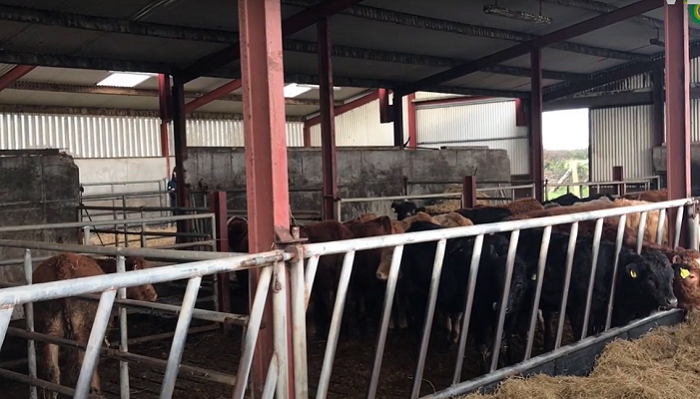27 February 2023
Watch: Housing for a part-time organic cattle enterprise

Fergus Hanly farms 30ha of free-draining land on the banks of the river Deel, just before it flows into the Shannon Estuary. He outlined his farming system and the adaptions he made to his housing as part of a recent Let’s Talk Organics webinar.
Fergus converted his farm to organics approximately 12 years ago. He operates a weanling to store/beef system, with approximately 35 weanlings purchased each October/November and retained on farm for a period of 12 months.
“I work off farm,” he explained, “I’m a part-time farmer. What I do is I buy weanlings in the autumn – October/November time – bring them straight into the shed, keep them in the shed until about – depending on the weather in the spring time – March.”
Turnout is targeted by March 17th and animals are grazed up until October. Depending on how well the animals have performed in the interim months, they are then either sold as stores or finished cattle.
Prior to converting to organics, Fergus used to house all cattle on slats. After switching to organic production, he built an extension on to the existing shed to provide a straw-bedded lie back area.
A new straw-bedded area, 7.6m wide, was added to the back of the slatted area. As the pillars on the existing shed were strong enough, he was able to graft onto these. Three 1.8m wide openings were cut out of the existing back wall to allow multiple access points for cattle to access the straw-bedded lie back.
Ventilated sheeting was erected along the back wall and the front section was left open, resulting in plenty of air flow in the shed. A cattle crush was built along the back wall of the shed and a large sliding door was constructed to allow easy access for cleaning out. A new manure pit was also built at the same time as the shed for storing the farmyard manure. Fergus uses a 4×4 bale of straw every three days and a load of 30 bales would last the winter. He cleans out the shed every 3-4 weeks.
Fergus paid his builder €40,000 (including VAT) at the time, but this included the construction of the manure pit, cattle crush and some remedial works to other sheds within the yard. He estimates that the shed was responsible for approximately €30,000 of the total spend. He did not receive any grants for the project.
